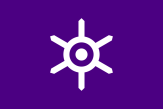


City flag
Main City: Tokyo
Population: 14,010,000 people, ranking 1/47 prefectures (2021)
Area: 2,187.66 km²
Geographical / Landscape description
The mainland portion of Tokyo lies northwest of Tokyo Bay and measures about 90 km east to west and 25 km north to south. The average elevation in Tokyo is 40 m. It is bordered by Chiba Prefecture to the east, Yamanashi to the west, Kanagawa to the south, and Saitama to the north. Mainland Tokyo is further subdivided into the 23 Special Wards occupying the eastern half, and the Tama area stretching westwards.
Also within the administrative boundaries of Tokyo Metropolis are two island chains in the Pacific Ocean lying directly south: the Izu Islands, and the Ogasawara Islands, which stretch for more than 1,000 km away from the mainland. Because of these islands and mountainous regions to the west, Tokyo's overall population density figures far under represent the real figures for urban and suburban regions of Tokyo.
Climate
Tokyo lies in the humid subtropical climate zone with hot humid summers and generally mild winters with cool spells. The region, like much of Japan, experiences a one-month seasonal lag, with the warmest month being August, which averages 27.5 °C, and the coolest month being January, averaging 6.0 °C. Annual rainfall averages nearly 1530 millimetres, with a wetter summer and a drier winter. Snowfall is sporadic but does occur almost annually. Tokyo also often sees typhoons each year, though few are strong.
Recent history, culture
Tokyo is often thought of as a city, but it is referred to as a "metropolitan prefecture". The Tokyo metropolitan government administers the 23 Special Wards of Tokyo (each governed as an individual city), which cover the area that was formerly the City of Tokyo before it merged and became the subsequent metropolitan prefecture. Tokyo is the capital of Japan, the centre of the Greater Tokyo Area, and the largest metropolitan area in the world. In 2020 (effectively in 2021) Tokyo hosted the 32nd Olympic Games; it was the second time in its history since 1964.
The city constantly gives rise to new fashions and cultural phenomena and a wide variety of information is transmitted to the rest of Japan and throughout the world. Famous sites and historical landmarks can be found, and traditional culture remains alive. The city presents an innovative face with a lingering atmosphere of tradition.
More chapters:
The EU-Japan Centre currently produces 5 newsletters :









